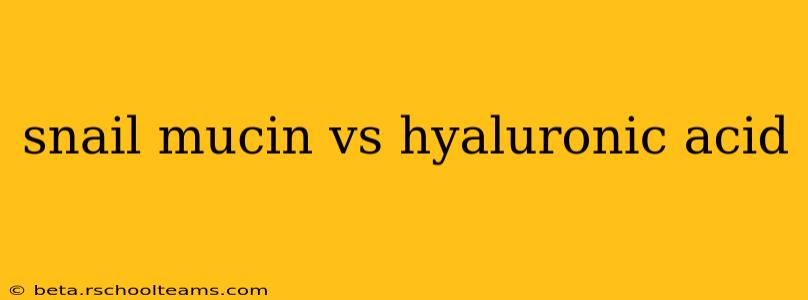Both snail mucin and hyaluronic acid are popular skincare ingredients touted for their moisturizing and skin-rejuvenating properties. But which one is better? The answer, as with most skincare choices, depends on your individual skin type and concerns. This article will delve into the specifics of each ingredient, comparing their benefits, drawbacks, and ideal applications to help you make an informed decision.
What is Snail Mucin?
Snail mucin is a secretion produced by snails. It's a viscous fluid containing a complex mixture of beneficial components, including glycolic acid, hyaluronic acid, copper peptides, and antimicrobial peptides. These components work synergistically to offer various skincare benefits.
Benefits of Snail Mucin:
- Hydration: Snail mucin's hyaluronic acid content contributes significantly to its moisturizing properties. It attracts and retains moisture, leaving skin feeling plump and hydrated.
- Wound Healing: The antimicrobial peptides and growth factors in snail mucin promote skin repair and regeneration, making it effective in treating acne scars, blemishes, and other skin imperfections.
- Anti-aging: The combination of antioxidants and growth factors in snail mucin can help reduce the appearance of fine lines and wrinkles, improving skin elasticity and firmness.
- Reduces Inflammation: Snail mucin possesses anti-inflammatory properties that can soothe irritated and sensitive skin.
What is Hyaluronic Acid?
Hyaluronic acid (HA) is a naturally occurring substance found in the human body. It's a humectant, meaning it draws moisture from the environment and binds it to the skin, resulting in intense hydration. Unlike snail mucin, it's a single molecule with a simpler composition.
Benefits of Hyaluronic Acid:
- Deep Hydration: HA's primary benefit is its exceptional ability to attract and retain water, leading to profoundly hydrated and plump skin.
- Improved Skin Texture: By increasing skin hydration, HA can improve skin texture, making it smoother and softer.
- Reduced Appearance of Fine Lines: The plumping effect of HA can temporarily reduce the appearance of fine lines and wrinkles.
- Versatile Ingredient: Hyaluronic acid is a widely used ingredient in various skincare products, from serums and moisturizers to cleansers and masks.
Snail Mucin vs. Hyaluronic Acid: A Detailed Comparison
| Feature | Snail Mucin | Hyaluronic Acid |
|---|---|---|
| Primary Benefit | Hydration, wound healing, anti-aging | Intense hydration |
| Composition | Complex mixture of components | Single molecule |
| Texture | Often slightly thicker, more viscous | Can range from thin serums to thicker gels |
| Absorption | Can vary depending on formulation | Generally absorbs quickly |
| Potential Side Effects | Rare, but some individuals may experience mild irritation | Rare, but some may experience mild stinging or dryness |
Which One Should You Choose?
The best choice depends on your skin's needs:
-
For dry, dehydrated skin: Both snail mucin and hyaluronic acid are excellent choices, offering intense hydration. You could even use them together for synergistic benefits.
-
For acne-prone skin: Snail mucin's wound-healing and antimicrobial properties can be beneficial in treating acne scars and blemishes.
-
For mature skin: Both ingredients can help improve skin elasticity and reduce the appearance of fine lines and wrinkles, though snail mucin offers additional benefits beyond just hydration.
-
For sensitive skin: Both ingredients are generally well-tolerated, but always patch test before applying to the entire face.
Can I Use Snail Mucin and Hyaluronic Acid Together?
Yes, absolutely! Many find that using both ingredients together enhances their individual benefits. The hyaluronic acid provides deep hydration, while the snail mucin offers additional skin-repairing and anti-aging properties. However, always apply the hyaluronic acid first as it generally absorbs more quickly.
What are the side effects of snail mucin and hyaluronic acid?
Both snail mucin and hyaluronic acid are generally well-tolerated, but some individuals may experience mild side effects. These might include redness, irritation, or a slight stinging sensation. If you experience any adverse reactions, discontinue use and consult a dermatologist.
Is snail mucin safe for sensitive skin?
While generally considered safe, individuals with sensitive skin should always perform a patch test before applying snail mucin to the entire face. This helps determine if any irritation or allergic reaction occurs.
Is hyaluronic acid effective for all skin types?
Hyaluronic acid is generally considered safe and effective for most skin types. However, those with extremely oily skin might find that some formulations are too heavy. Choosing a lightweight, water-based hyaluronic acid serum can help mitigate this.
By understanding the unique properties of each ingredient, you can choose the best option – or combination – to achieve your desired skincare goals. Remember to always patch test new products and consult a dermatologist if you have any concerns.
